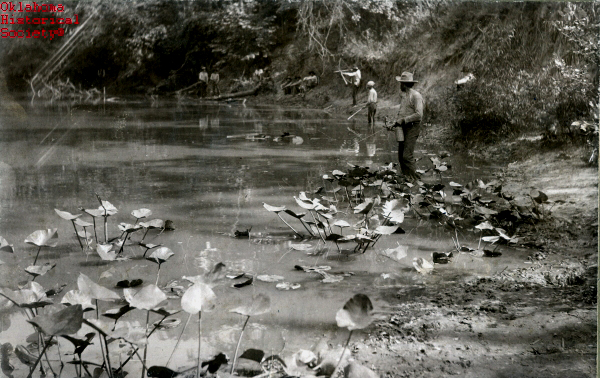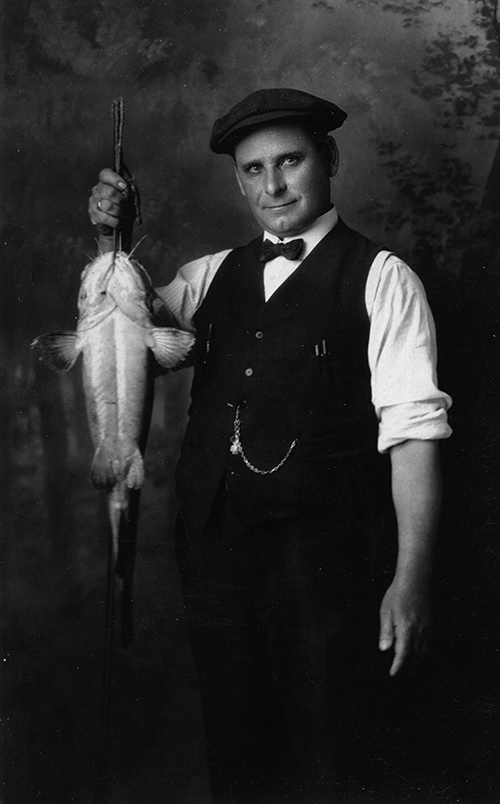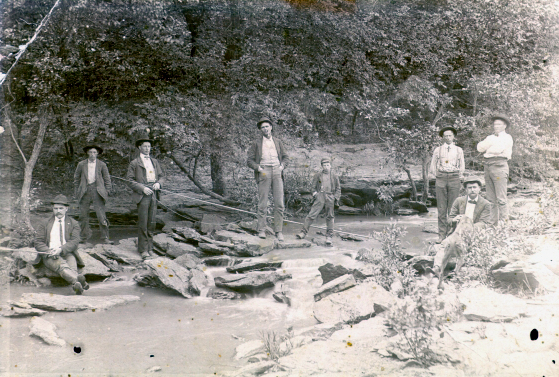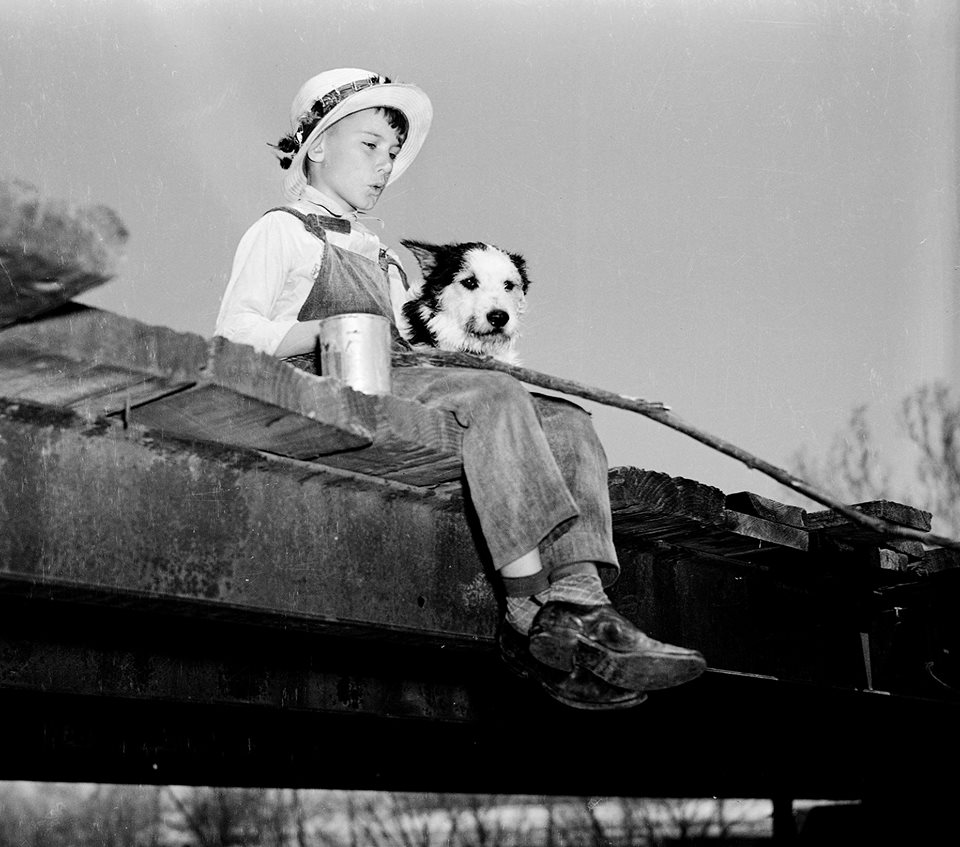FISHING.
Oklahoma is one of the most water-rich states in the union, but readers of John Steinbeck's classic novel The Grapes of Wrath would not know it. Steinbeck describes a stark, dry, and gritty landscape, but the state has come a long way since the 1930s Dust Bowl. Modern Oklahoma is a recreation destination, offering nearly 1.2 million acres of impounded water and a vast diversity of fishing and boating opportunities. The state has twenty-three thousand miles of rivers and streams and seventy-three reservoirs larger than five hundred acres, containing a combined a total of 660,000 acres. With all this water comes a rich fishing history.
Oklahoma's first game and fish laws were passed in 1895, under territorial government. At that time no state administrative office for game and fish existed, so local county and township officers enforced the game and fish laws. While fish and game had seemed an inexhaustible resource to exploit, at the turn of the twentieth century many people recognized these were limited resources that needed to be conserved. In 1903 the Territorial Game and Fish Protective Association was organized. In 1909 the association presented the second state legislature with a bill asking the governor to appoint a state game warden. The law passed, creating the Office of the State Game Warden, later called the Game and Fish Department (now the Department of Wildlife Conservation). Hunting licenses were also created this same year, but separate fishing licenses would not become available until 1925.
Closed from 1913 through 1914, the state game warden's office was reinstated in 1915. The agency built the first state hatchery, at Medicine Park near Lawton, after funding was restored for the specific purpose of developing game preserves and building fish hatcheries. Hatcheries were built near Durant (1916–17), Tahlequah (1924–26), Heavener (1925–26), and Cherokee (1929). At the beginning of the twenty-first century Oklahoma's four hatcheries (Durant, Holdenville, Byron, and the J. A. Manning Hatchery near Lawton) annually produced millions of fish to be stocked in reservoirs and ponds throughout the state. Hatcheries have also hosted a variety of research projects aimed at improving Oklahoma fisheries.
In 1925 the Oklahoma division of the Izaak Walton League influenced the legislature to create a Game and Fish Commission. Formed in Chicago in 1922 and named for a seventeenth-century conservationist who wrote The Compleat Angler, the Izaak Walton League endorsed many conservation issues, battled pollution, and lobbied for fish hatcheries, public hunting refuges, and sporting regulations. In 1923 the league came to Oklahoma when chapter number one appeared at Westville. The president of the Oklahoma City chapter, Earl Stapleton, emerged as a dynamic leader and advocate. By 1924 there were twelve strong, active chapters, and approximately forty more were organizing. Although hunting licenses had been available for fifteen years, the first separate fishing licenses were issued in 1925; they cost $1.25. Since that time license dollars have provided critical funding for fisheries-related projects, a true user-pay, user-benefit arrangement.
The 1930s and early 1940s brought refinement to the fish and game management techniques, and sport fishing continued to grow as a popular leisure-time activity for Oklahomans. The game and fish statutes were updated in 1949, with fees for fishing and hunting licenses rising to $2 each, or $3.50 for a combination license. According to the U.S. Fish and Wildlife Service, in 1937–38 Oklahoma issued 119,263 fishing licenses, which escalated to 360,204 resident licenses in 1948–49.
In 1950 the U.S. Congress passed the Sport Fish Restoration Act. Modeled after the successful Wildlife Restoration Act, which helped restore America's wildlife resources, the Sport Fish Restoration Act proposed to restore and improve the nation's sport fisheries with a special excise tax on fishing equipment and, later, on fuel used by boaters and anglers. Revenues generated from this tax were then distributed to the states to be used in sport-fish restoration projects and for public access development on public waters. Funds have been used to develop some of the nation's best black bass fisheries as well as outstanding walleye and saugeye fisheries. This act made boat ramps, fishing piers, and handicapped-access facilities possible.
In 1958 the first rainbow trout were stocked in the Illinois River, and Oklahoma's trout-stocking program proved a success. The department manages eight areas designated for trout fishing, providing fishing opportunities that early-day Oklahomans could never have imagined. The six winter-only trout areas attract considerable interest during the sport's traditional off-season, and the two year-round fisheries, particularly that on the lower Mountain Fork River in McCurtain County, draw anglers from hundreds of miles.
Long regarded as a very good bass fishing destination, in 1965 Lake Texoma added striped bass. Originally a saltwater fish, the striped bass adapted well to the expansive waters of the border lake. Stripers not only offered a new exciting sport, but also proved valuable for managing gizzard shad. By reducing the average size of this large shad, the striper makes them available to all fish, thereby increasing game-fish productivity in the lake. Besides providing anglers excellent fishing opportunities, Texoma's striper fishery also generates millions of dollars to the local economy, which in many respects owes its existence to this facility. The agency now stocks striped bass in suitable habitats around the state. Monitoring the striped bass population through annual surveys has allowed the department to manipulate length limits and creel limits to benefit sport fishing. Telemetry studies help biologists and anglers determine the stripers' seasonal movements and patterns. With this information, anglers can fish successfully for stripers year round.
One of the state's most sought-after fish, the largemouth bass, received a serious boost in the early 1970s when Florida largemouth bass were introduced into Oklahoma's gene pool. The record book illustrates the impact of the Florida strain of bass on the growth potential of Oklahoma bass. In 1983, just a decade after the introduction, Oklahoma's largemouth bass record fell after standing forty-two years. For several years afterward the record fell almost annually, and the fish that first eclipsed the state record in 1983 is no longer even in Oklahoma's Top Twenty. In fact, every bass in the Oklahoma Top Twenty contains Florida genes. Other bass-related projects going on at this time, when bass fishing was beginning to boom nationwide, included temperature tolerance studies, movement/telemetry studies, habitat suitability studies, and monitoring populations for management purposes. As a result of these and other projects Oklahoma's bass anglers have access to better fishing.
In the early 1980s fisheries biologists identified a need to bolster fish habitat in many reservoirs across the state. More than two-thirds of the state's major reservoirs have been impounded for thirty years or longer and some for much longer. Consequently, fish habitat had deteriorated from sedimentation and vegetation decay following inundation. In response, the department implemented the Aquatic Habitat Improvement Program in Oklahoma reservoirs in 1983. The program improves aquatic habitat by planting vegetation, creating fish habitat structures, enhancing spawning beds, fertilizing, and manipulating water levels. Vegetation control includes plantings on shorelines and in mid-reservoir with mudflat seeding and the planting of emergent, floating and submerged vegetation.
The department's Aquatic Resources Education Pro-gram has proven to be one of its most far-reaching efforts. Initiated in 1988, the program annually introduces approximately eighteen thousand youths to the sport of fishing and instructs them on a wide variety of topics, from understanding outdoor ethics to using a rod and reel. Virtually all of the clinics give a young person a chance to catch a fish. More than 175 clinics are held each year across the state, from isolated farm ponds to parks in the heart of Tulsa and Oklahoma City.
Largely as a result of the 1958 Wildlife Restoration Act, by the end of the twentieth century sport fishing had become one of America's most lucrative industries. By 1969, 486,437 Oklahoma residents purchased fishing licenses, and the number rose to 634,740 in 1982. In 1999 resident fishing licenses numbered 634,740. Sport fishing contributes more than $1 billion annually to the economy and creates nearly fifteen thousand jobs in the Sooner State.
Learn More
William Cunningham, "Militant Anglers in Oklahoma," Harlow's Weekly 23 (March 1, 1924).
Fishing in Oklahoma (Oklahoma City: Oklahoma Department of Wildlife Conservation, 1984).
John Allen Gifford, Oklahoma Sportfishing: A Complete Sportsman's Guide (Woodstock, Vt.: Backcountry Guides, 2002).
John W. Morris, ed., Geography of Oklahoma (Oklahoma City: Oklahoma Historical Society, 1977).
Citation
The following (as per The Chicago Manual of Style, 17th edition) is the preferred citation for articles:
Micah Holmes, “Fishing,” The Encyclopedia of Oklahoma History and Culture, https://www.okhistory.org/publications/enc/entry?entry=FI012.
Published January 15, 2010
© Oklahoma Historical Society





